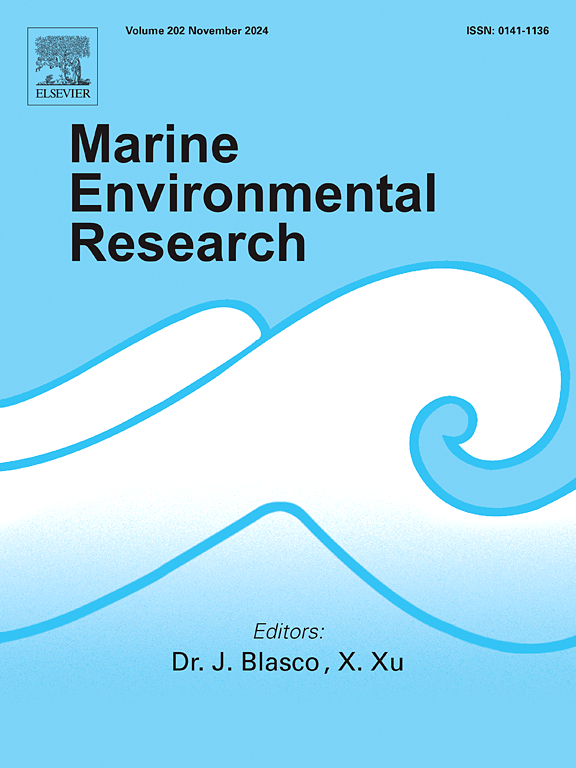Rapid surveying of benthopelagic ecosystems with a towed mini-ROV
IF 3
3区 环境科学与生态学
Q2 ENVIRONMENTAL SCIENCES
引用次数: 0
Abstract
Surveying benthic communities has historically relied on snorkel or SCUBA, but these methods are labour-intensive, inefficient (∼1000 m2 per day covered for one dive pair) and depth-limited (<30 m depth). Here we detail a remote method using a towed mini-ROV that combines the depth capabilities and endurance of towed cameras with the flexibility and manoeuvrability of SCUBA and snorkel. Towed mini-ROV allows over 10 km of transects or 38,000 m2 of benthic surveys per day, produces data that can be geo-referenced, allows measurement of organisms using orthomosaics, can include physical data such as depth and temperature, and can operate from depths of 2–60 m without any gear changes. This setup requires only modest modifications of readily available equipment, and is relatively low-cost given the time and labour efficiencies gained. We provide some examples of the types of data that can be produced (video, imagery, spatial layer), as well as the sort of coverage that is realistic using real survey data obtained from the Great Barrier Reef, Australia. Results demonstrate this approach could be used on a large scale to rapidly survey benthic environments. It could be further improved by using a more hydrodynamic ROV design, and a more streamline pipeline that integrates data sources. Use of underwater positioning systems could improve spatial parameters, lasers could improve measurement accuracy, and additional cameras could increase spatial coverage, but at the cost of added complexity and hydrodynamic drag.
拖曳式微型rov快速测量底栖生态系统
调查底栖生物群落历来依赖于浮潜或水肺,但这些方法劳动密集,效率低下(一对潜水对每天覆盖约1000平方米)且深度有限(30米深)。在这里,我们详细介绍了一种使用拖曳式微型rov的远程方法,该方法结合了拖曳式摄像机的深度能力和耐用性以及水肺和通气管的灵活性和机动性。拖曳式微型rov每天可以进行超过10公里的横断面或38,000平方米的底栖生物调查,产生的数据可以作为地理参考,允许使用正形测量生物,可以包括深度和温度等物理数据,并且可以在2-60米的深度下工作,而无需更换齿轮。这种设置只需要对现有设备进行适度的修改,并且考虑到所获得的时间和劳动效率,成本相对较低。我们提供了一些可以生成的数据类型(视频,图像,空间层)的示例,以及使用从澳大利亚大堡礁获得的真实调查数据的逼真覆盖类型。结果表明,该方法可以大规模地用于快速调查底栖环境。通过使用更具水动力的ROV设计,以及集成数据源的更流线型的管道,可以进一步改进。使用水下定位系统可以改善空间参数,激光可以提高测量精度,额外的相机可以增加空间覆盖,但代价是增加了复杂性和水动力阻力。
本文章由计算机程序翻译,如有差异,请以英文原文为准。
求助全文
约1分钟内获得全文
求助全文
来源期刊

Marine environmental research
环境科学-毒理学
CiteScore
5.90
自引率
3.00%
发文量
217
审稿时长
46 days
期刊介绍:
Marine Environmental Research publishes original research papers on chemical, physical, and biological interactions in the oceans and coastal waters. The journal serves as a forum for new information on biology, chemistry, and toxicology and syntheses that advance understanding of marine environmental processes.
Submission of multidisciplinary studies is encouraged. Studies that utilize experimental approaches to clarify the roles of anthropogenic and natural causes of changes in marine ecosystems are especially welcome, as are those studies that represent new developments of a theoretical or conceptual aspect of marine science. All papers published in this journal are reviewed by qualified peers prior to acceptance and publication. Examples of topics considered to be appropriate for the journal include, but are not limited to, the following:
– The extent, persistence, and consequences of change and the recovery from such change in natural marine systems
– The biochemical, physiological, and ecological consequences of contaminants to marine organisms and ecosystems
– The biogeochemistry of naturally occurring and anthropogenic substances
– Models that describe and predict the above processes
– Monitoring studies, to the extent that their results provide new information on functional processes
– Methodological papers describing improved quantitative techniques for the marine sciences.
 求助内容:
求助内容: 应助结果提醒方式:
应助结果提醒方式:


